University Assignment: NRSG355 Clinical Integration Module Solutions
VerifiedAdded on 2022/10/17
|11
|3095
|18
Homework Assignment
AI Summary
This document presents comprehensive solutions for the NRSG355 Clinical Integration assignment, addressing key aspects of nursing practice across four modules. Module 1 focuses on critical thinking, clinical decision-making, and professional development, including prioritization and delegation of tasks in various clinical scenarios. Module 2 delves into collaborative and therapeutic practice, examining the roles of healthcare teams and addressing patient case studies. Module 3 concentrates on the provision and coordination of care, with a focus on patient assessment and data collection. Finally, Module 4 explores professional practice, including time management, delegation strategies, and scope of practice considerations within the nursing profession. The solutions are supported by relevant literature and address practical application of theoretical concepts to real-world clinical situations.
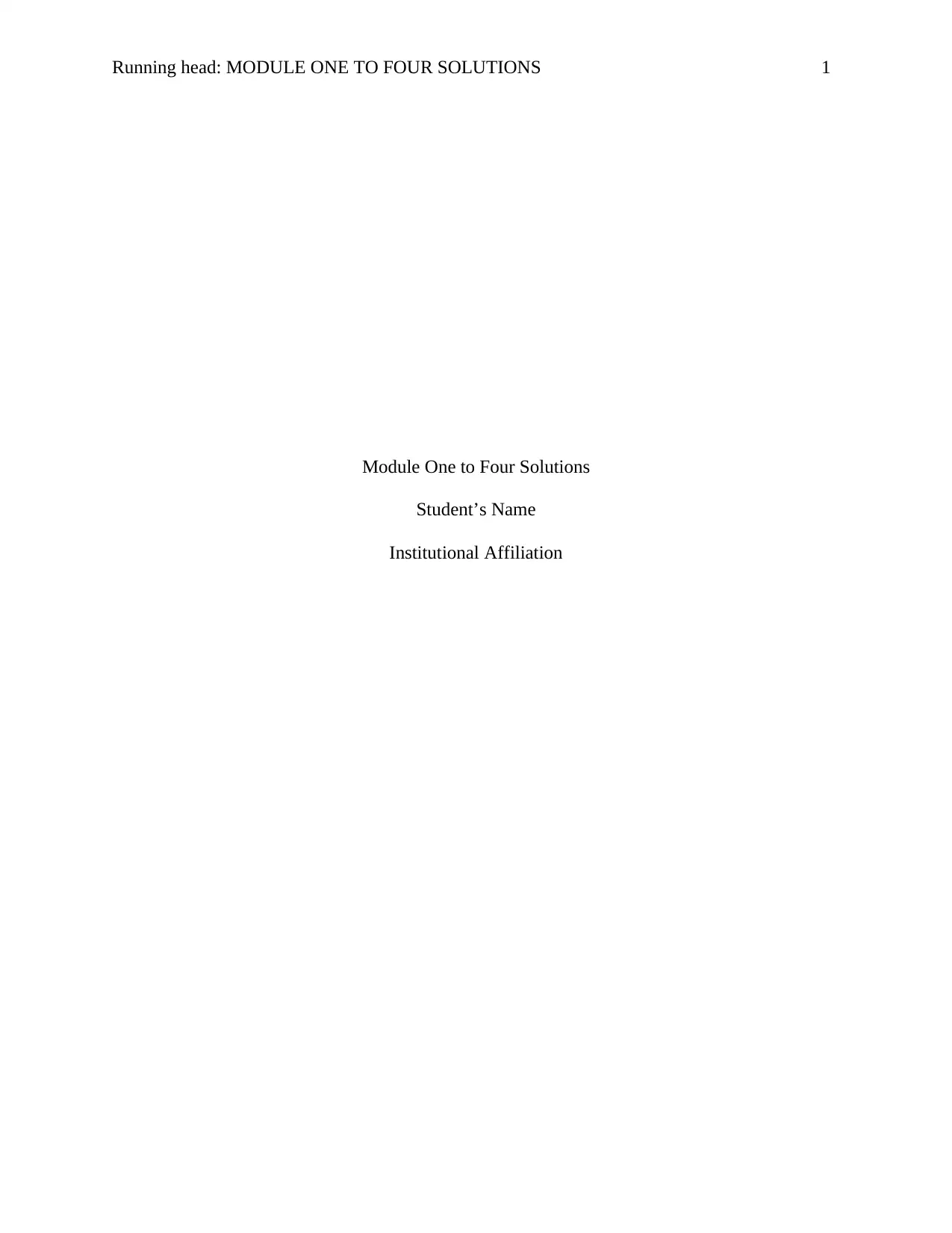
Running head: MODULE ONE TO FOUR SOLUTIONS 1
Module One to Four Solutions
Student’s Name
Institutional Affiliation
Module One to Four Solutions
Student’s Name
Institutional Affiliation
Paraphrase This Document
Need a fresh take? Get an instant paraphrase of this document with our AI Paraphraser
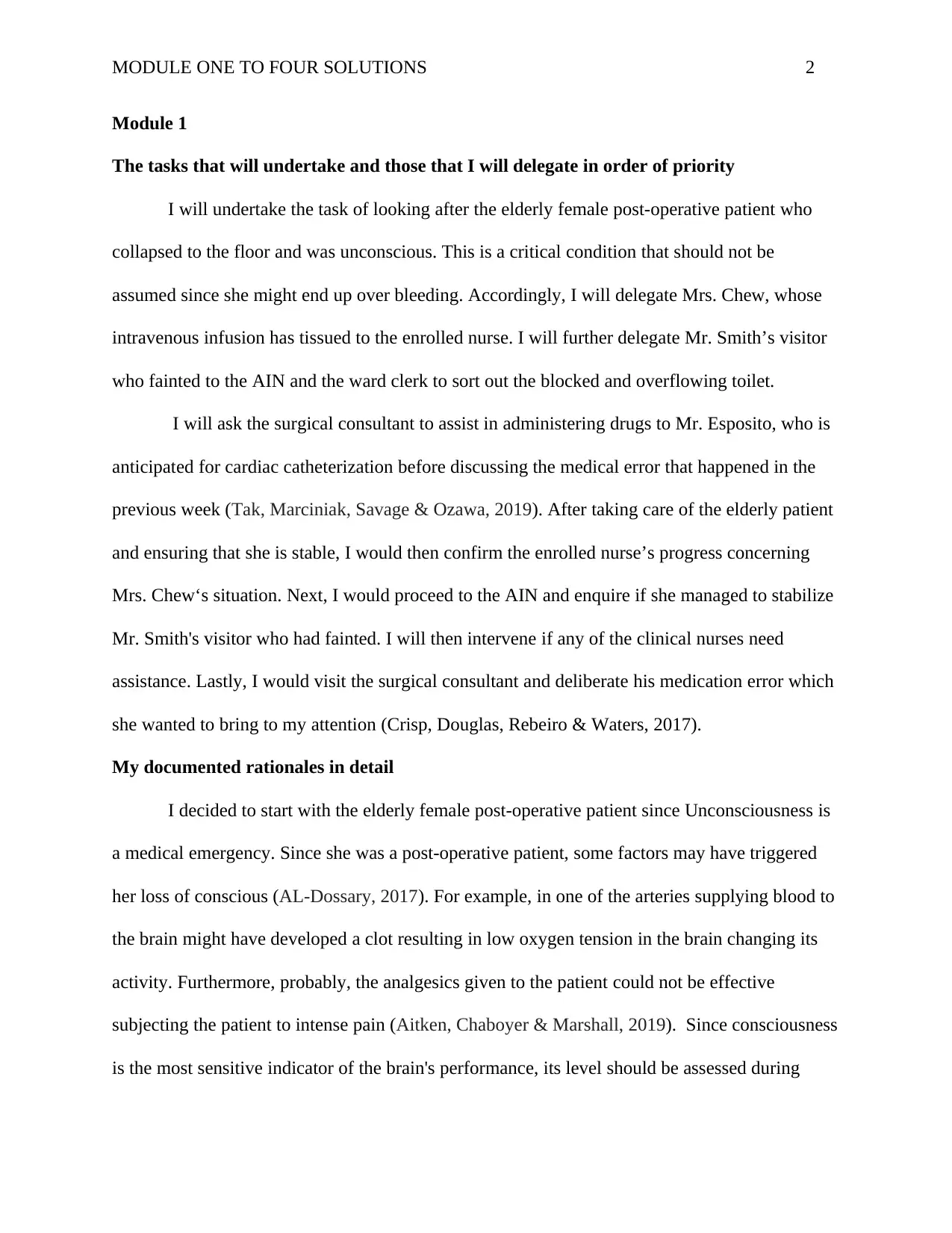
MODULE ONE TO FOUR SOLUTIONS 2
Module 1
The tasks that will undertake and those that I will delegate in order of priority
I will undertake the task of looking after the elderly female post-operative patient who
collapsed to the floor and was unconscious. This is a critical condition that should not be
assumed since she might end up over bleeding. Accordingly, I will delegate Mrs. Chew, whose
intravenous infusion has tissued to the enrolled nurse. I will further delegate Mr. Smith’s visitor
who fainted to the AIN and the ward clerk to sort out the blocked and overflowing toilet.
I will ask the surgical consultant to assist in administering drugs to Mr. Esposito, who is
anticipated for cardiac catheterization before discussing the medical error that happened in the
previous week (Tak, Marciniak, Savage & Ozawa, 2019). After taking care of the elderly patient
and ensuring that she is stable, I would then confirm the enrolled nurse’s progress concerning
Mrs. Chew‘s situation. Next, I would proceed to the AIN and enquire if she managed to stabilize
Mr. Smith's visitor who had fainted. I will then intervene if any of the clinical nurses need
assistance. Lastly, I would visit the surgical consultant and deliberate his medication error which
she wanted to bring to my attention (Crisp, Douglas, Rebeiro & Waters, 2017).
My documented rationales in detail
I decided to start with the elderly female post-operative patient since Unconsciousness is
a medical emergency. Since she was a post-operative patient, some factors may have triggered
her loss of conscious (AL-Dossary, 2017). For example, in one of the arteries supplying blood to
the brain might have developed a clot resulting in low oxygen tension in the brain changing its
activity. Furthermore, probably, the analgesics given to the patient could not be effective
subjecting the patient to intense pain (Aitken, Chaboyer & Marshall, 2019). Since consciousness
is the most sensitive indicator of the brain's performance, its level should be assessed during
Module 1
The tasks that will undertake and those that I will delegate in order of priority
I will undertake the task of looking after the elderly female post-operative patient who
collapsed to the floor and was unconscious. This is a critical condition that should not be
assumed since she might end up over bleeding. Accordingly, I will delegate Mrs. Chew, whose
intravenous infusion has tissued to the enrolled nurse. I will further delegate Mr. Smith’s visitor
who fainted to the AIN and the ward clerk to sort out the blocked and overflowing toilet.
I will ask the surgical consultant to assist in administering drugs to Mr. Esposito, who is
anticipated for cardiac catheterization before discussing the medical error that happened in the
previous week (Tak, Marciniak, Savage & Ozawa, 2019). After taking care of the elderly patient
and ensuring that she is stable, I would then confirm the enrolled nurse’s progress concerning
Mrs. Chew‘s situation. Next, I would proceed to the AIN and enquire if she managed to stabilize
Mr. Smith's visitor who had fainted. I will then intervene if any of the clinical nurses need
assistance. Lastly, I would visit the surgical consultant and deliberate his medication error which
she wanted to bring to my attention (Crisp, Douglas, Rebeiro & Waters, 2017).
My documented rationales in detail
I decided to start with the elderly female post-operative patient since Unconsciousness is
a medical emergency. Since she was a post-operative patient, some factors may have triggered
her loss of conscious (AL-Dossary, 2017). For example, in one of the arteries supplying blood to
the brain might have developed a clot resulting in low oxygen tension in the brain changing its
activity. Furthermore, probably, the analgesics given to the patient could not be effective
subjecting the patient to intense pain (Aitken, Chaboyer & Marshall, 2019). Since consciousness
is the most sensitive indicator of the brain's performance, its level should be assessed during
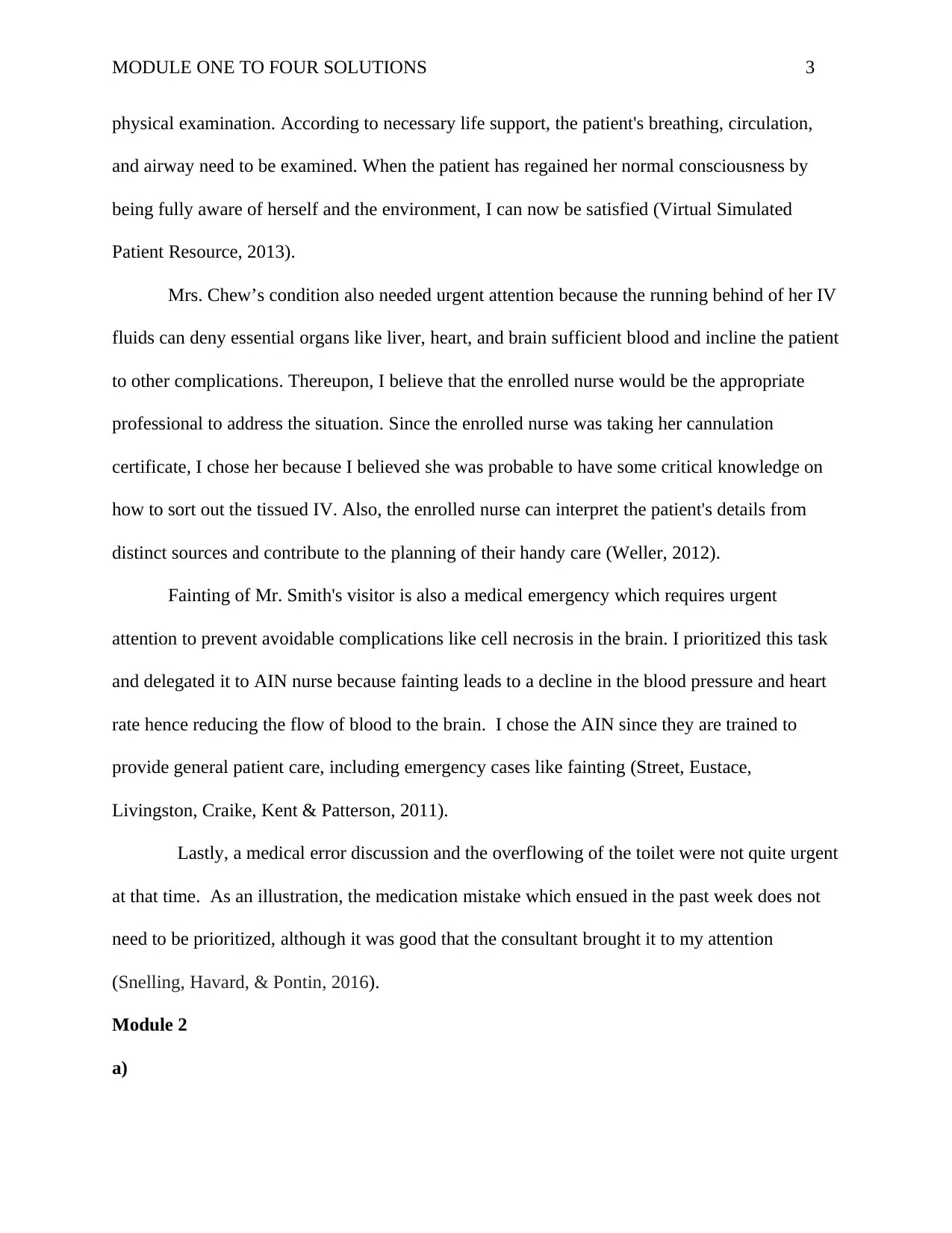
MODULE ONE TO FOUR SOLUTIONS 3
physical examination. According to necessary life support, the patient's breathing, circulation,
and airway need to be examined. When the patient has regained her normal consciousness by
being fully aware of herself and the environment, I can now be satisfied (Virtual Simulated
Patient Resource, 2013).
Mrs. Chew’s condition also needed urgent attention because the running behind of her IV
fluids can deny essential organs like liver, heart, and brain sufficient blood and incline the patient
to other complications. Thereupon, I believe that the enrolled nurse would be the appropriate
professional to address the situation. Since the enrolled nurse was taking her cannulation
certificate, I chose her because I believed she was probable to have some critical knowledge on
how to sort out the tissued IV. Also, the enrolled nurse can interpret the patient's details from
distinct sources and contribute to the planning of their handy care (Weller, 2012).
Fainting of Mr. Smith's visitor is also a medical emergency which requires urgent
attention to prevent avoidable complications like cell necrosis in the brain. I prioritized this task
and delegated it to AIN nurse because fainting leads to a decline in the blood pressure and heart
rate hence reducing the flow of blood to the brain. I chose the AIN since they are trained to
provide general patient care, including emergency cases like fainting (Street, Eustace,
Livingston, Craike, Kent & Patterson, 2011).
Lastly, a medical error discussion and the overflowing of the toilet were not quite urgent
at that time. As an illustration, the medication mistake which ensued in the past week does not
need to be prioritized, although it was good that the consultant brought it to my attention
(Snelling, Havard, & Pontin, 2016).
Module 2
a)
physical examination. According to necessary life support, the patient's breathing, circulation,
and airway need to be examined. When the patient has regained her normal consciousness by
being fully aware of herself and the environment, I can now be satisfied (Virtual Simulated
Patient Resource, 2013).
Mrs. Chew’s condition also needed urgent attention because the running behind of her IV
fluids can deny essential organs like liver, heart, and brain sufficient blood and incline the patient
to other complications. Thereupon, I believe that the enrolled nurse would be the appropriate
professional to address the situation. Since the enrolled nurse was taking her cannulation
certificate, I chose her because I believed she was probable to have some critical knowledge on
how to sort out the tissued IV. Also, the enrolled nurse can interpret the patient's details from
distinct sources and contribute to the planning of their handy care (Weller, 2012).
Fainting of Mr. Smith's visitor is also a medical emergency which requires urgent
attention to prevent avoidable complications like cell necrosis in the brain. I prioritized this task
and delegated it to AIN nurse because fainting leads to a decline in the blood pressure and heart
rate hence reducing the flow of blood to the brain. I chose the AIN since they are trained to
provide general patient care, including emergency cases like fainting (Street, Eustace,
Livingston, Craike, Kent & Patterson, 2011).
Lastly, a medical error discussion and the overflowing of the toilet were not quite urgent
at that time. As an illustration, the medication mistake which ensued in the past week does not
need to be prioritized, although it was good that the consultant brought it to my attention
(Snelling, Havard, & Pontin, 2016).
Module 2
a)
⊘ This is a preview!⊘
Do you want full access?
Subscribe today to unlock all pages.

Trusted by 1+ million students worldwide
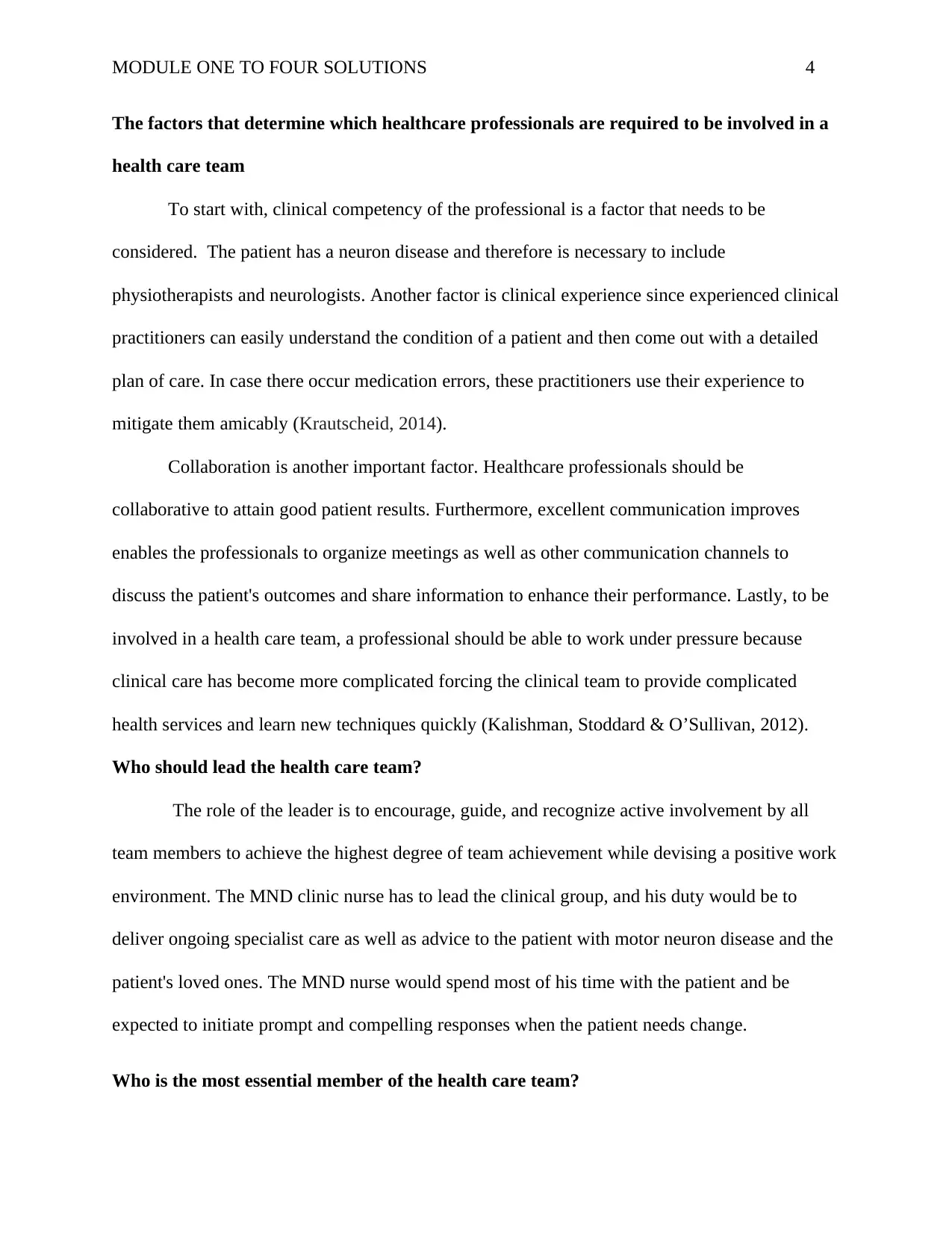
MODULE ONE TO FOUR SOLUTIONS 4
The factors that determine which healthcare professionals are required to be involved in a
health care team
To start with, clinical competency of the professional is a factor that needs to be
considered. The patient has a neuron disease and therefore is necessary to include
physiotherapists and neurologists. Another factor is clinical experience since experienced clinical
practitioners can easily understand the condition of a patient and then come out with a detailed
plan of care. In case there occur medication errors, these practitioners use their experience to
mitigate them amicably (Krautscheid, 2014).
Collaboration is another important factor. Healthcare professionals should be
collaborative to attain good patient results. Furthermore, excellent communication improves
enables the professionals to organize meetings as well as other communication channels to
discuss the patient's outcomes and share information to enhance their performance. Lastly, to be
involved in a health care team, a professional should be able to work under pressure because
clinical care has become more complicated forcing the clinical team to provide complicated
health services and learn new techniques quickly (Kalishman, Stoddard & O’Sullivan, 2012).
Who should lead the health care team?
The role of the leader is to encourage, guide, and recognize active involvement by all
team members to achieve the highest degree of team achievement while devising a positive work
environment. The MND clinic nurse has to lead the clinical group, and his duty would be to
deliver ongoing specialist care as well as advice to the patient with motor neuron disease and the
patient's loved ones. The MND nurse would spend most of his time with the patient and be
expected to initiate prompt and compelling responses when the patient needs change.
Who is the most essential member of the health care team?
The factors that determine which healthcare professionals are required to be involved in a
health care team
To start with, clinical competency of the professional is a factor that needs to be
considered. The patient has a neuron disease and therefore is necessary to include
physiotherapists and neurologists. Another factor is clinical experience since experienced clinical
practitioners can easily understand the condition of a patient and then come out with a detailed
plan of care. In case there occur medication errors, these practitioners use their experience to
mitigate them amicably (Krautscheid, 2014).
Collaboration is another important factor. Healthcare professionals should be
collaborative to attain good patient results. Furthermore, excellent communication improves
enables the professionals to organize meetings as well as other communication channels to
discuss the patient's outcomes and share information to enhance their performance. Lastly, to be
involved in a health care team, a professional should be able to work under pressure because
clinical care has become more complicated forcing the clinical team to provide complicated
health services and learn new techniques quickly (Kalishman, Stoddard & O’Sullivan, 2012).
Who should lead the health care team?
The role of the leader is to encourage, guide, and recognize active involvement by all
team members to achieve the highest degree of team achievement while devising a positive work
environment. The MND clinic nurse has to lead the clinical group, and his duty would be to
deliver ongoing specialist care as well as advice to the patient with motor neuron disease and the
patient's loved ones. The MND nurse would spend most of his time with the patient and be
expected to initiate prompt and compelling responses when the patient needs change.
Who is the most essential member of the health care team?
Paraphrase This Document
Need a fresh take? Get an instant paraphrase of this document with our AI Paraphraser
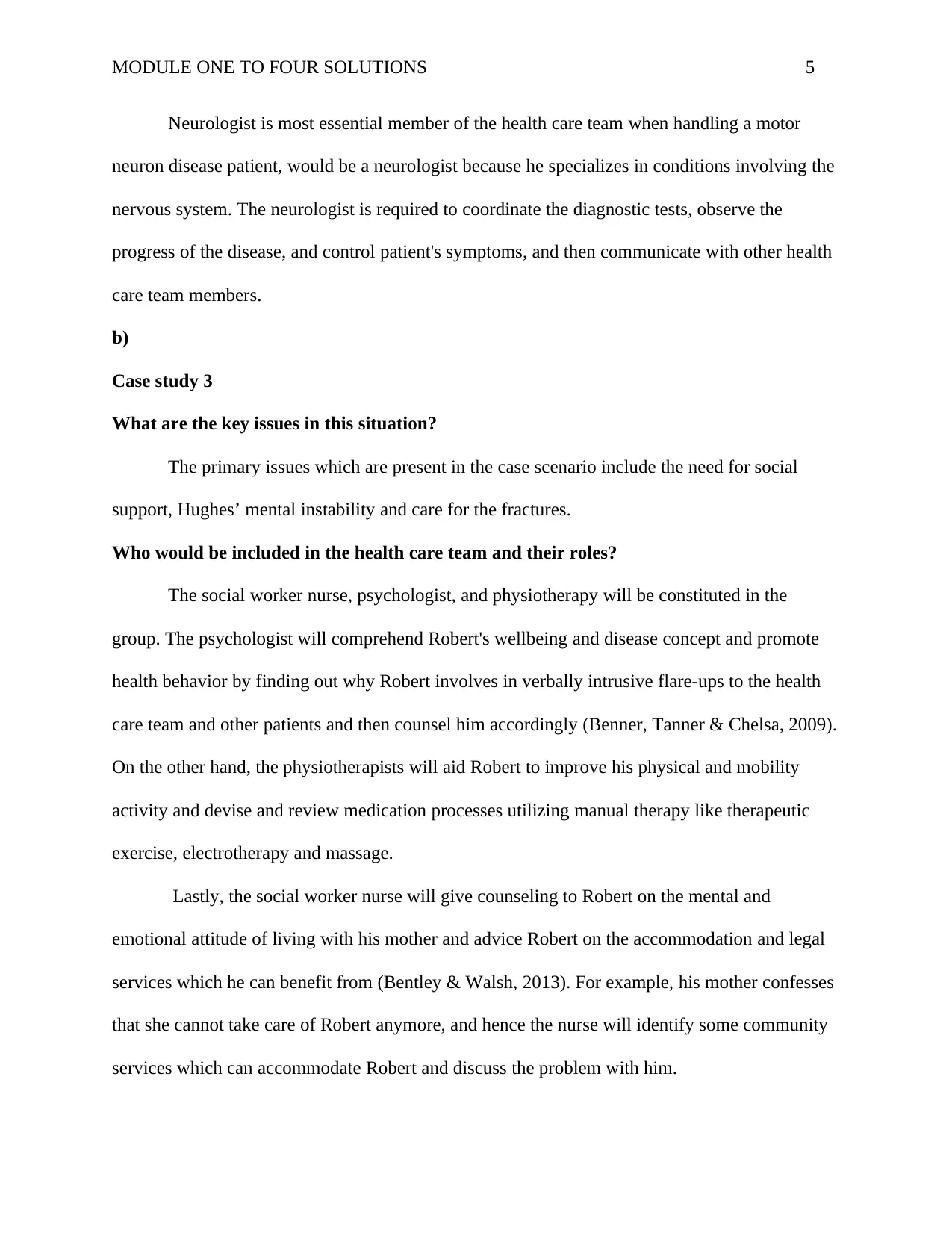
MODULE ONE TO FOUR SOLUTIONS 5
Neurologist is most essential member of the health care team when handling a motor
neuron disease patient, would be a neurologist because he specializes in conditions involving the
nervous system. The neurologist is required to coordinate the diagnostic tests, observe the
progress of the disease, and control patient's symptoms, and then communicate with other health
care team members.
b)
Case study 3
What are the key issues in this situation?
The primary issues which are present in the case scenario include the need for social
support, Hughes’ mental instability and care for the fractures.
Who would be included in the health care team and their roles?
The social worker nurse, psychologist, and physiotherapy will be constituted in the
group. The psychologist will comprehend Robert's wellbeing and disease concept and promote
health behavior by finding out why Robert involves in verbally intrusive flare-ups to the health
care team and other patients and then counsel him accordingly (Benner, Tanner & Chelsa, 2009).
On the other hand, the physiotherapists will aid Robert to improve his physical and mobility
activity and devise and review medication processes utilizing manual therapy like therapeutic
exercise, electrotherapy and massage.
Lastly, the social worker nurse will give counseling to Robert on the mental and
emotional attitude of living with his mother and advice Robert on the accommodation and legal
services which he can benefit from (Bentley & Walsh, 2013). For example, his mother confesses
that she cannot take care of Robert anymore, and hence the nurse will identify some community
services which can accommodate Robert and discuss the problem with him.
Neurologist is most essential member of the health care team when handling a motor
neuron disease patient, would be a neurologist because he specializes in conditions involving the
nervous system. The neurologist is required to coordinate the diagnostic tests, observe the
progress of the disease, and control patient's symptoms, and then communicate with other health
care team members.
b)
Case study 3
What are the key issues in this situation?
The primary issues which are present in the case scenario include the need for social
support, Hughes’ mental instability and care for the fractures.
Who would be included in the health care team and their roles?
The social worker nurse, psychologist, and physiotherapy will be constituted in the
group. The psychologist will comprehend Robert's wellbeing and disease concept and promote
health behavior by finding out why Robert involves in verbally intrusive flare-ups to the health
care team and other patients and then counsel him accordingly (Benner, Tanner & Chelsa, 2009).
On the other hand, the physiotherapists will aid Robert to improve his physical and mobility
activity and devise and review medication processes utilizing manual therapy like therapeutic
exercise, electrotherapy and massage.
Lastly, the social worker nurse will give counseling to Robert on the mental and
emotional attitude of living with his mother and advice Robert on the accommodation and legal
services which he can benefit from (Bentley & Walsh, 2013). For example, his mother confesses
that she cannot take care of Robert anymore, and hence the nurse will identify some community
services which can accommodate Robert and discuss the problem with him.
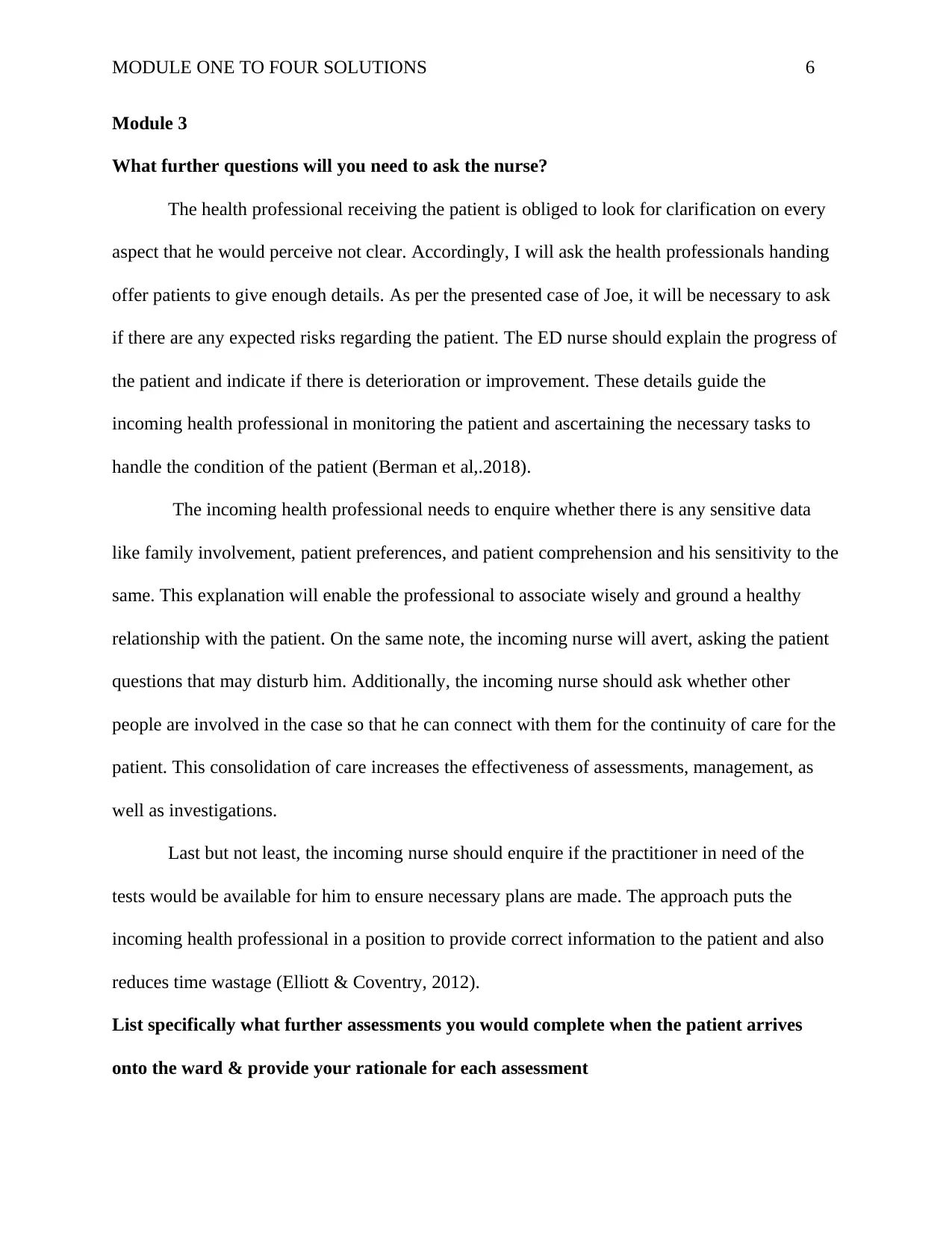
MODULE ONE TO FOUR SOLUTIONS 6
Module 3
What further questions will you need to ask the nurse?
The health professional receiving the patient is obliged to look for clarification on every
aspect that he would perceive not clear. Accordingly, I will ask the health professionals handing
offer patients to give enough details. As per the presented case of Joe, it will be necessary to ask
if there are any expected risks regarding the patient. The ED nurse should explain the progress of
the patient and indicate if there is deterioration or improvement. These details guide the
incoming health professional in monitoring the patient and ascertaining the necessary tasks to
handle the condition of the patient (Berman et al,.2018).
The incoming health professional needs to enquire whether there is any sensitive data
like family involvement, patient preferences, and patient comprehension and his sensitivity to the
same. This explanation will enable the professional to associate wisely and ground a healthy
relationship with the patient. On the same note, the incoming nurse will avert, asking the patient
questions that may disturb him. Additionally, the incoming nurse should ask whether other
people are involved in the case so that he can connect with them for the continuity of care for the
patient. This consolidation of care increases the effectiveness of assessments, management, as
well as investigations.
Last but not least, the incoming nurse should enquire if the practitioner in need of the
tests would be available for him to ensure necessary plans are made. The approach puts the
incoming health professional in a position to provide correct information to the patient and also
reduces time wastage (Elliott & Coventry, 2012).
List specifically what further assessments you would complete when the patient arrives
onto the ward & provide your rationale for each assessment
Module 3
What further questions will you need to ask the nurse?
The health professional receiving the patient is obliged to look for clarification on every
aspect that he would perceive not clear. Accordingly, I will ask the health professionals handing
offer patients to give enough details. As per the presented case of Joe, it will be necessary to ask
if there are any expected risks regarding the patient. The ED nurse should explain the progress of
the patient and indicate if there is deterioration or improvement. These details guide the
incoming health professional in monitoring the patient and ascertaining the necessary tasks to
handle the condition of the patient (Berman et al,.2018).
The incoming health professional needs to enquire whether there is any sensitive data
like family involvement, patient preferences, and patient comprehension and his sensitivity to the
same. This explanation will enable the professional to associate wisely and ground a healthy
relationship with the patient. On the same note, the incoming nurse will avert, asking the patient
questions that may disturb him. Additionally, the incoming nurse should ask whether other
people are involved in the case so that he can connect with them for the continuity of care for the
patient. This consolidation of care increases the effectiveness of assessments, management, as
well as investigations.
Last but not least, the incoming nurse should enquire if the practitioner in need of the
tests would be available for him to ensure necessary plans are made. The approach puts the
incoming health professional in a position to provide correct information to the patient and also
reduces time wastage (Elliott & Coventry, 2012).
List specifically what further assessments you would complete when the patient arrives
onto the ward & provide your rationale for each assessment
⊘ This is a preview!⊘
Do you want full access?
Subscribe today to unlock all pages.

Trusted by 1+ million students worldwide
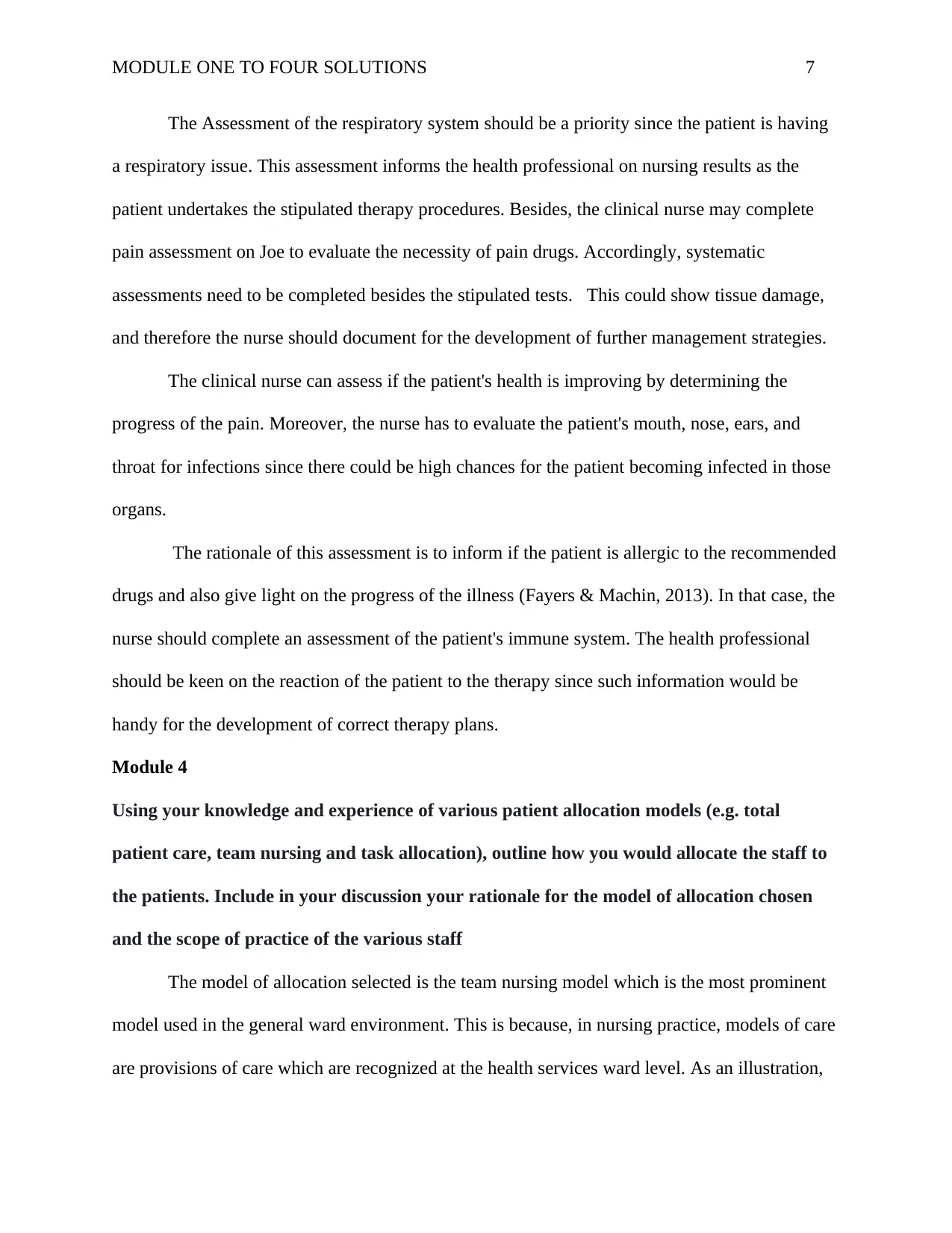
MODULE ONE TO FOUR SOLUTIONS 7
The Assessment of the respiratory system should be a priority since the patient is having
a respiratory issue. This assessment informs the health professional on nursing results as the
patient undertakes the stipulated therapy procedures. Besides, the clinical nurse may complete
pain assessment on Joe to evaluate the necessity of pain drugs. Accordingly, systematic
assessments need to be completed besides the stipulated tests. This could show tissue damage,
and therefore the nurse should document for the development of further management strategies.
The clinical nurse can assess if the patient's health is improving by determining the
progress of the pain. Moreover, the nurse has to evaluate the patient's mouth, nose, ears, and
throat for infections since there could be high chances for the patient becoming infected in those
organs.
The rationale of this assessment is to inform if the patient is allergic to the recommended
drugs and also give light on the progress of the illness (Fayers & Machin, 2013). In that case, the
nurse should complete an assessment of the patient's immune system. The health professional
should be keen on the reaction of the patient to the therapy since such information would be
handy for the development of correct therapy plans.
Module 4
Using your knowledge and experience of various patient allocation models (e.g. total
patient care, team nursing and task allocation), outline how you would allocate the staff to
the patients. Include in your discussion your rationale for the model of allocation chosen
and the scope of practice of the various staff
The model of allocation selected is the team nursing model which is the most prominent
model used in the general ward environment. This is because, in nursing practice, models of care
are provisions of care which are recognized at the health services ward level. As an illustration,
The Assessment of the respiratory system should be a priority since the patient is having
a respiratory issue. This assessment informs the health professional on nursing results as the
patient undertakes the stipulated therapy procedures. Besides, the clinical nurse may complete
pain assessment on Joe to evaluate the necessity of pain drugs. Accordingly, systematic
assessments need to be completed besides the stipulated tests. This could show tissue damage,
and therefore the nurse should document for the development of further management strategies.
The clinical nurse can assess if the patient's health is improving by determining the
progress of the pain. Moreover, the nurse has to evaluate the patient's mouth, nose, ears, and
throat for infections since there could be high chances for the patient becoming infected in those
organs.
The rationale of this assessment is to inform if the patient is allergic to the recommended
drugs and also give light on the progress of the illness (Fayers & Machin, 2013). In that case, the
nurse should complete an assessment of the patient's immune system. The health professional
should be keen on the reaction of the patient to the therapy since such information would be
handy for the development of correct therapy plans.
Module 4
Using your knowledge and experience of various patient allocation models (e.g. total
patient care, team nursing and task allocation), outline how you would allocate the staff to
the patients. Include in your discussion your rationale for the model of allocation chosen
and the scope of practice of the various staff
The model of allocation selected is the team nursing model which is the most prominent
model used in the general ward environment. This is because, in nursing practice, models of care
are provisions of care which are recognized at the health services ward level. As an illustration,
Paraphrase This Document
Need a fresh take? Get an instant paraphrase of this document with our AI Paraphraser
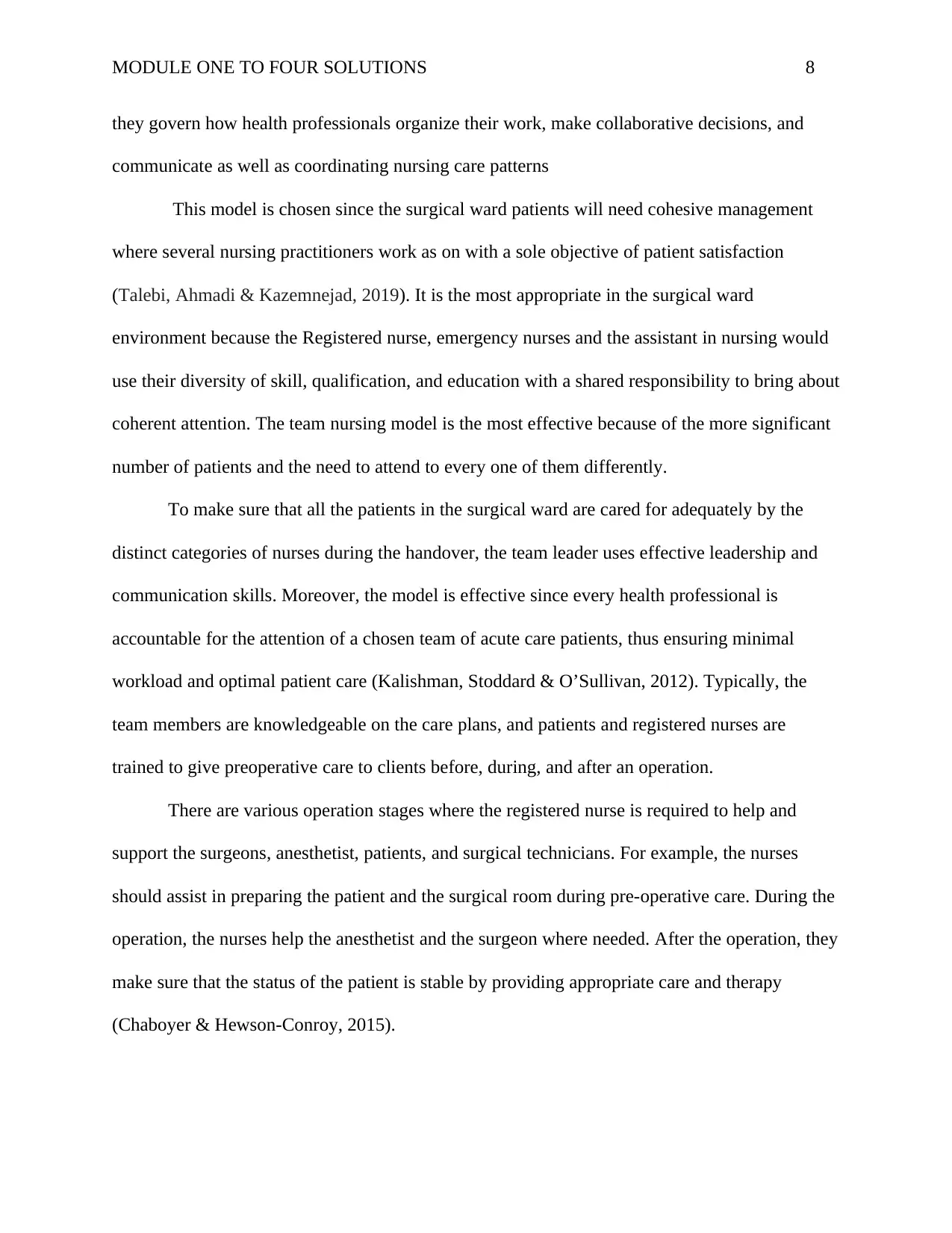
MODULE ONE TO FOUR SOLUTIONS 8
they govern how health professionals organize their work, make collaborative decisions, and
communicate as well as coordinating nursing care patterns
This model is chosen since the surgical ward patients will need cohesive management
where several nursing practitioners work as on with a sole objective of patient satisfaction
(Talebi, Ahmadi & Kazemnejad, 2019). It is the most appropriate in the surgical ward
environment because the Registered nurse, emergency nurses and the assistant in nursing would
use their diversity of skill, qualification, and education with a shared responsibility to bring about
coherent attention. The team nursing model is the most effective because of the more significant
number of patients and the need to attend to every one of them differently.
To make sure that all the patients in the surgical ward are cared for adequately by the
distinct categories of nurses during the handover, the team leader uses effective leadership and
communication skills. Moreover, the model is effective since every health professional is
accountable for the attention of a chosen team of acute care patients, thus ensuring minimal
workload and optimal patient care (Kalishman, Stoddard & O’Sullivan, 2012). Typically, the
team members are knowledgeable on the care plans, and patients and registered nurses are
trained to give preoperative care to clients before, during, and after an operation.
There are various operation stages where the registered nurse is required to help and
support the surgeons, anesthetist, patients, and surgical technicians. For example, the nurses
should assist in preparing the patient and the surgical room during pre-operative care. During the
operation, the nurses help the anesthetist and the surgeon where needed. After the operation, they
make sure that the status of the patient is stable by providing appropriate care and therapy
(Chaboyer & Hewson-Conroy, 2015).
they govern how health professionals organize their work, make collaborative decisions, and
communicate as well as coordinating nursing care patterns
This model is chosen since the surgical ward patients will need cohesive management
where several nursing practitioners work as on with a sole objective of patient satisfaction
(Talebi, Ahmadi & Kazemnejad, 2019). It is the most appropriate in the surgical ward
environment because the Registered nurse, emergency nurses and the assistant in nursing would
use their diversity of skill, qualification, and education with a shared responsibility to bring about
coherent attention. The team nursing model is the most effective because of the more significant
number of patients and the need to attend to every one of them differently.
To make sure that all the patients in the surgical ward are cared for adequately by the
distinct categories of nurses during the handover, the team leader uses effective leadership and
communication skills. Moreover, the model is effective since every health professional is
accountable for the attention of a chosen team of acute care patients, thus ensuring minimal
workload and optimal patient care (Kalishman, Stoddard & O’Sullivan, 2012). Typically, the
team members are knowledgeable on the care plans, and patients and registered nurses are
trained to give preoperative care to clients before, during, and after an operation.
There are various operation stages where the registered nurse is required to help and
support the surgeons, anesthetist, patients, and surgical technicians. For example, the nurses
should assist in preparing the patient and the surgical room during pre-operative care. During the
operation, the nurses help the anesthetist and the surgeon where needed. After the operation, they
make sure that the status of the patient is stable by providing appropriate care and therapy
(Chaboyer & Hewson-Conroy, 2015).
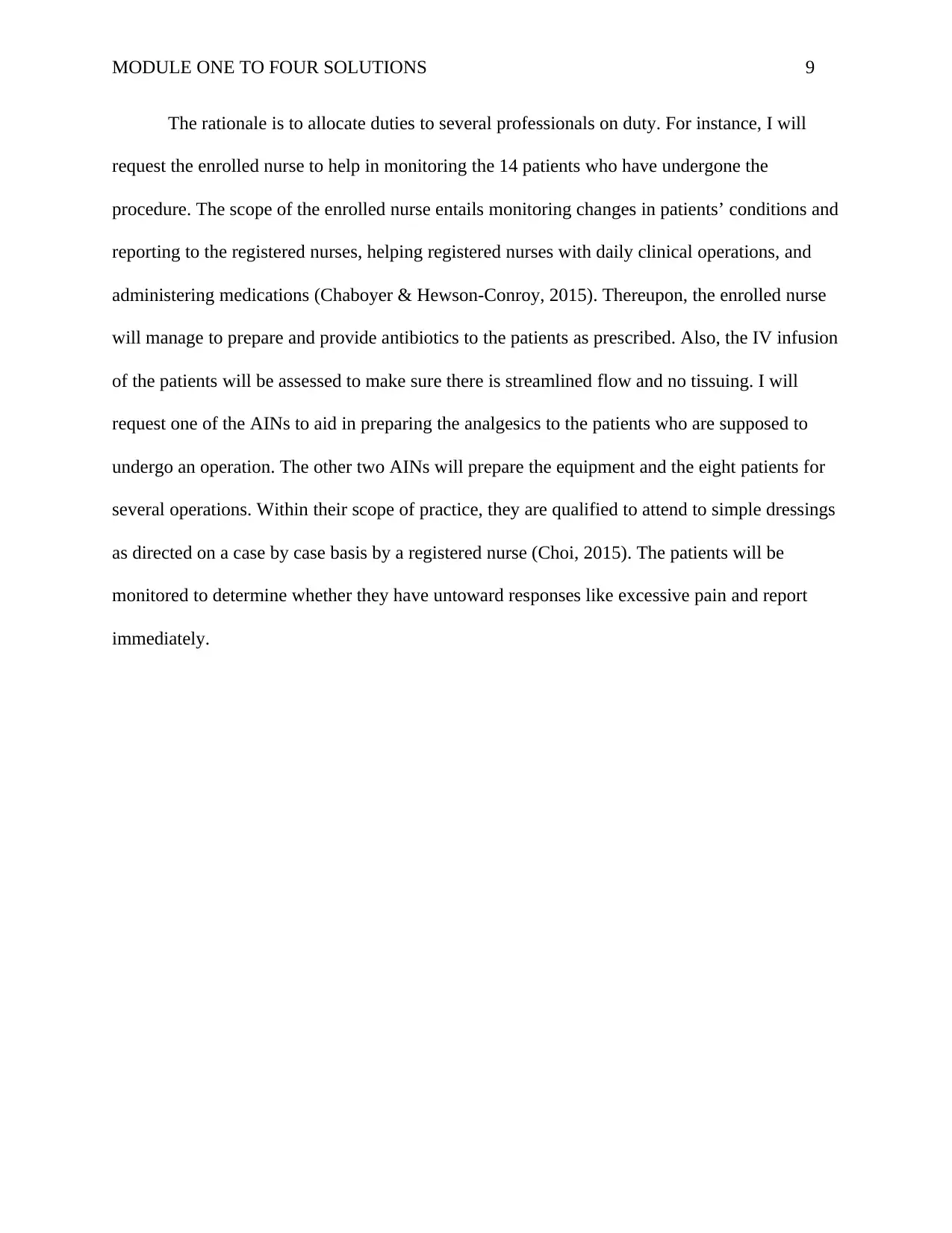
MODULE ONE TO FOUR SOLUTIONS 9
The rationale is to allocate duties to several professionals on duty. For instance, I will
request the enrolled nurse to help in monitoring the 14 patients who have undergone the
procedure. The scope of the enrolled nurse entails monitoring changes in patients’ conditions and
reporting to the registered nurses, helping registered nurses with daily clinical operations, and
administering medications (Chaboyer & Hewson-Conroy, 2015). Thereupon, the enrolled nurse
will manage to prepare and provide antibiotics to the patients as prescribed. Also, the IV infusion
of the patients will be assessed to make sure there is streamlined flow and no tissuing. I will
request one of the AINs to aid in preparing the analgesics to the patients who are supposed to
undergo an operation. The other two AINs will prepare the equipment and the eight patients for
several operations. Within their scope of practice, they are qualified to attend to simple dressings
as directed on a case by case basis by a registered nurse (Choi, 2015). The patients will be
monitored to determine whether they have untoward responses like excessive pain and report
immediately.
The rationale is to allocate duties to several professionals on duty. For instance, I will
request the enrolled nurse to help in monitoring the 14 patients who have undergone the
procedure. The scope of the enrolled nurse entails monitoring changes in patients’ conditions and
reporting to the registered nurses, helping registered nurses with daily clinical operations, and
administering medications (Chaboyer & Hewson-Conroy, 2015). Thereupon, the enrolled nurse
will manage to prepare and provide antibiotics to the patients as prescribed. Also, the IV infusion
of the patients will be assessed to make sure there is streamlined flow and no tissuing. I will
request one of the AINs to aid in preparing the analgesics to the patients who are supposed to
undergo an operation. The other two AINs will prepare the equipment and the eight patients for
several operations. Within their scope of practice, they are qualified to attend to simple dressings
as directed on a case by case basis by a registered nurse (Choi, 2015). The patients will be
monitored to determine whether they have untoward responses like excessive pain and report
immediately.
⊘ This is a preview!⊘
Do you want full access?
Subscribe today to unlock all pages.

Trusted by 1+ million students worldwide
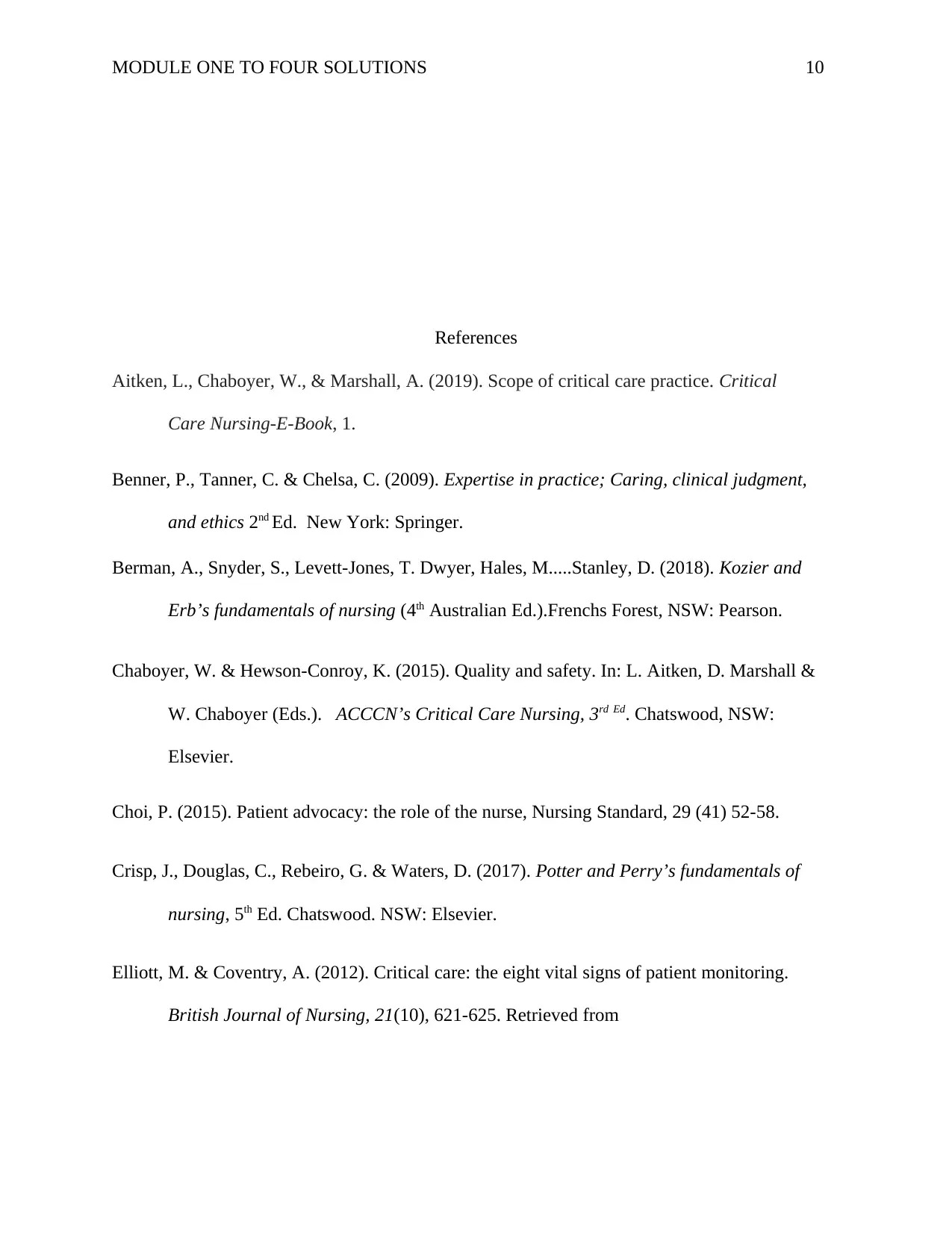
MODULE ONE TO FOUR SOLUTIONS 10
References
Aitken, L., Chaboyer, W., & Marshall, A. (2019). Scope of critical care practice. Critical
Care Nursing-E-Book, 1.
Benner, P., Tanner, C. & Chelsa, C. (2009). Expertise in practice; Caring, clinical judgment,
and ethics 2nd Ed. New York: Springer.
Berman, A., Snyder, S., Levett-Jones, T. Dwyer, Hales, M.....Stanley, D. (2018). Kozier and
Erb’s fundamentals of nursing (4th Australian Ed.).Frenchs Forest, NSW: Pearson.
Chaboyer, W. & Hewson-Conroy, K. (2015). Quality and safety. In: L. Aitken, D. Marshall &
W. Chaboyer (Eds.). ACCCN’s Critical Care Nursing, 3rd Ed. Chatswood, NSW:
Elsevier.
Choi, P. (2015). Patient advocacy: the role of the nurse, Nursing Standard, 29 (41) 52-58.
Crisp, J., Douglas, C., Rebeiro, G. & Waters, D. (2017). Potter and Perry’s fundamentals of
nursing, 5th Ed. Chatswood. NSW: Elsevier.
Elliott, M. & Coventry, A. (2012). Critical care: the eight vital signs of patient monitoring.
British Journal of Nursing, 21(10), 621-625. Retrieved from
References
Aitken, L., Chaboyer, W., & Marshall, A. (2019). Scope of critical care practice. Critical
Care Nursing-E-Book, 1.
Benner, P., Tanner, C. & Chelsa, C. (2009). Expertise in practice; Caring, clinical judgment,
and ethics 2nd Ed. New York: Springer.
Berman, A., Snyder, S., Levett-Jones, T. Dwyer, Hales, M.....Stanley, D. (2018). Kozier and
Erb’s fundamentals of nursing (4th Australian Ed.).Frenchs Forest, NSW: Pearson.
Chaboyer, W. & Hewson-Conroy, K. (2015). Quality and safety. In: L. Aitken, D. Marshall &
W. Chaboyer (Eds.). ACCCN’s Critical Care Nursing, 3rd Ed. Chatswood, NSW:
Elsevier.
Choi, P. (2015). Patient advocacy: the role of the nurse, Nursing Standard, 29 (41) 52-58.
Crisp, J., Douglas, C., Rebeiro, G. & Waters, D. (2017). Potter and Perry’s fundamentals of
nursing, 5th Ed. Chatswood. NSW: Elsevier.
Elliott, M. & Coventry, A. (2012). Critical care: the eight vital signs of patient monitoring.
British Journal of Nursing, 21(10), 621-625. Retrieved from
Paraphrase This Document
Need a fresh take? Get an instant paraphrase of this document with our AI Paraphraser
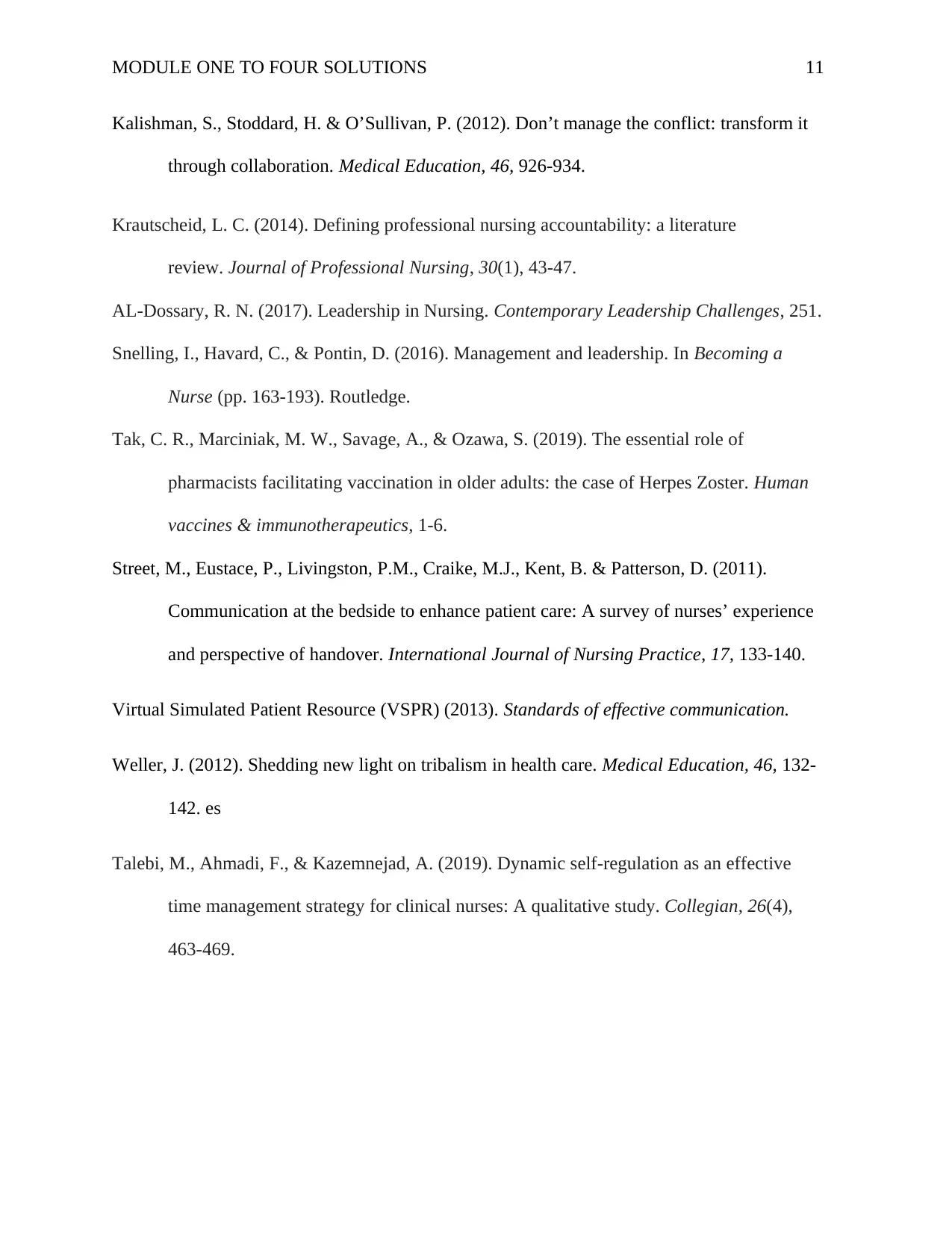
MODULE ONE TO FOUR SOLUTIONS 11
Kalishman, S., Stoddard, H. & O’Sullivan, P. (2012). Don’t manage the conflict: transform it
through collaboration. Medical Education, 46, 926-934.
Krautscheid, L. C. (2014). Defining professional nursing accountability: a literature
review. Journal of Professional Nursing, 30(1), 43-47.
AL-Dossary, R. N. (2017). Leadership in Nursing. Contemporary Leadership Challenges, 251.
Snelling, I., Havard, C., & Pontin, D. (2016). Management and leadership. In Becoming a
Nurse (pp. 163-193). Routledge.
Tak, C. R., Marciniak, M. W., Savage, A., & Ozawa, S. (2019). The essential role of
pharmacists facilitating vaccination in older adults: the case of Herpes Zoster. Human
vaccines & immunotherapeutics, 1-6.
Street, M., Eustace, P., Livingston, P.M., Craike, M.J., Kent, B. & Patterson, D. (2011).
Communication at the bedside to enhance patient care: A survey of nurses’ experience
and perspective of handover. International Journal of Nursing Practice, 17, 133-140.
Virtual Simulated Patient Resource (VSPR) (2013). Standards of effective communication.
Weller, J. (2012). Shedding new light on tribalism in health care. Medical Education, 46, 132-
142. es
Talebi, M., Ahmadi, F., & Kazemnejad, A. (2019). Dynamic self-regulation as an effective
time management strategy for clinical nurses: A qualitative study. Collegian, 26(4),
463-469.
Kalishman, S., Stoddard, H. & O’Sullivan, P. (2012). Don’t manage the conflict: transform it
through collaboration. Medical Education, 46, 926-934.
Krautscheid, L. C. (2014). Defining professional nursing accountability: a literature
review. Journal of Professional Nursing, 30(1), 43-47.
AL-Dossary, R. N. (2017). Leadership in Nursing. Contemporary Leadership Challenges, 251.
Snelling, I., Havard, C., & Pontin, D. (2016). Management and leadership. In Becoming a
Nurse (pp. 163-193). Routledge.
Tak, C. R., Marciniak, M. W., Savage, A., & Ozawa, S. (2019). The essential role of
pharmacists facilitating vaccination in older adults: the case of Herpes Zoster. Human
vaccines & immunotherapeutics, 1-6.
Street, M., Eustace, P., Livingston, P.M., Craike, M.J., Kent, B. & Patterson, D. (2011).
Communication at the bedside to enhance patient care: A survey of nurses’ experience
and perspective of handover. International Journal of Nursing Practice, 17, 133-140.
Virtual Simulated Patient Resource (VSPR) (2013). Standards of effective communication.
Weller, J. (2012). Shedding new light on tribalism in health care. Medical Education, 46, 132-
142. es
Talebi, M., Ahmadi, F., & Kazemnejad, A. (2019). Dynamic self-regulation as an effective
time management strategy for clinical nurses: A qualitative study. Collegian, 26(4),
463-469.
1 out of 11
Related Documents
Your All-in-One AI-Powered Toolkit for Academic Success.
+13062052269
info@desklib.com
Available 24*7 on WhatsApp / Email
![[object Object]](/_next/static/media/star-bottom.7253800d.svg)
Unlock your academic potential
Copyright © 2020–2025 A2Z Services. All Rights Reserved. Developed and managed by ZUCOL.





